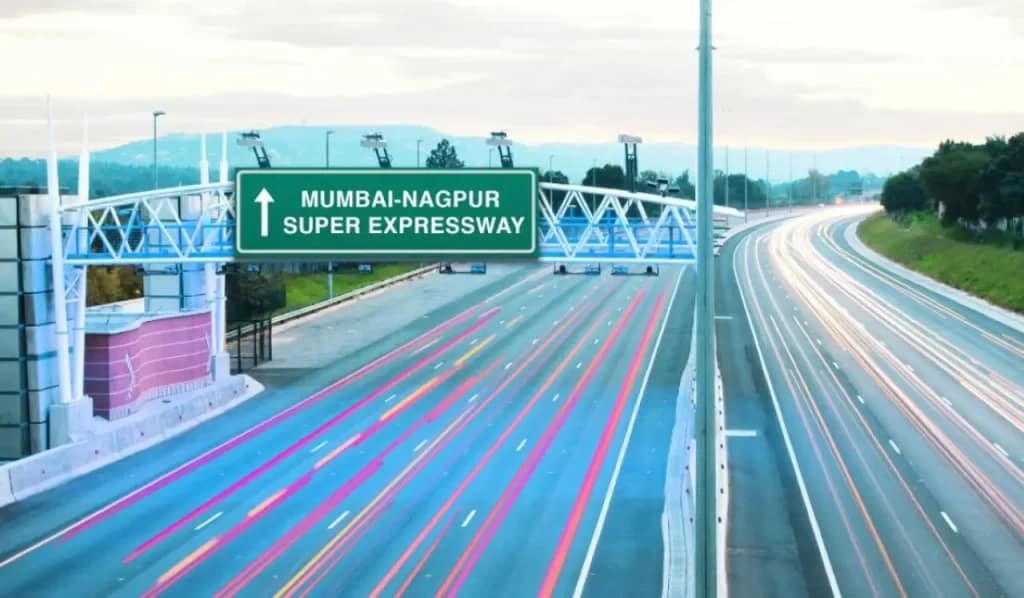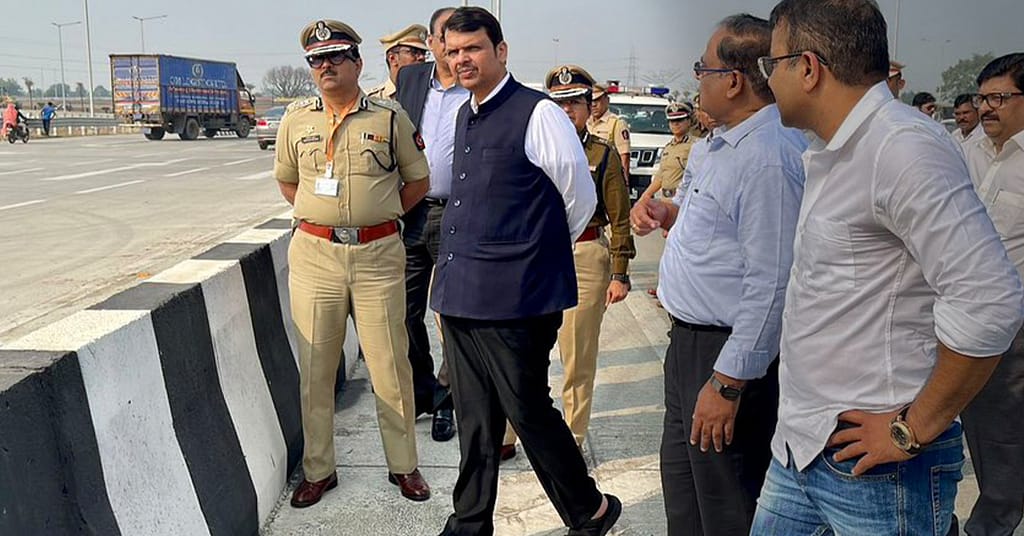The first of the mega infrastructure projects envisioned and undertaken by Devendra Fadnavis once he became the CM was the building of a strategic expressway between Nagpur and Mumbai that will open many new growth avenues for the state and lay the path of development to the hinterland of Maharashtra. However, behind the success of this monumental project, there was a saga of stiff resistance to land acquisition and how his government turned the resistance into voluntary participation
The Nagpur-Mumbai expressway at a glance
The 701 km. long Nagpur-Mumbai 6-lane expressway connects 390 villages and industrial areas of 10 districts along with other important facilities, such as the Delhi-Mumbai Industrial Corridor (DMIC), the Western Dedicated Freight Corridor (WDFC), dry ports at Wardha and Jalna, and JNPT Port of Mumbai.
There are service roads on both sides of this highway, connected by underpass roads at many places. Also, this route has more than 50 flyovers, interchanges at 25 points, and tunnels at five to six points. The capacity of this Mahamarg is so huge that it does not create any hindrance to traffic on underpasses and flyovers.
Elaborate landscaping and other beautifications, good tunnel lighting, and digital signages have been used in this expressway on par with international standards. Also, automatic machines were used for toll collection. CCTV and free-dial telephone booths have been set up every 5 km to help motorists to help with emergencies. Also, to meet natural calamities or war-like situations, the expressway will be capable of emergency landing of aircraft. Fiber optic cables, gas pipelines, and electricity cables can also run along this expressway.
Named the Hindu Hrudayasamrat Balasaheb Thackeray Sammruddhi Mahamarg, this 6-lane (upgradable to 8- lane) Nagpur-Mumbai super expressway is a testament to conceiving a pathbreaking idea and showing enormous grit to bring it to fruition.
Why is this project considered historic? Because this is the costliest infrastructure project ever in India, meets the top quality international standard, and is executed in record time (Covid break to be considered). The Fadnavis government displayed adept handling to overcome the two major hurdles that cripple many ambitious projects – land acquisition and slow execution.
80% of the land required for this highway was acquired within 1 year. The administrative skills and firm determination of the then Chief Minister Devendra Fadnavis were instrumental in achieving this rare feat.
A similar resolve was demonstrated to complete a giant project like this in record time. Here are some insights:

Application of land pool model for land acquisition of Samruddhi Highway
Building a new infrastructure of this scale required large tracts of land over several districts spanning hundreds of kilometers. This is not easy and often gets entangled in long-standing court cases and political resistance. Besides, for numerous landowners, a piece of land provides livelihood, security, and social standing.
The Fadnavis government was keen on ensuring fair and transparent compensation to the farmers and landowners, but couldn’t let the project cost overshoot due to heavy compensation.
So it came up with a special scheme of creating a land pool through voluntary participation and land acquisition using the Land Acquisition Act 2013. The land pool scheme served both objectives i.e. ensuring sufficient land for the expressway and allied developments yet keeping the budget within the limit. By availing of the land pool scheme the voluntary participants stood to benefit in several ways.
Land pooling is an activity where a group of landowners hand over their land parcels to the government collectively for infrastructure development. Once the development is complete, the land is handed over to the original owners, after deducting some portion as the cost for the development. The primary benefit of land pooling policy is that the ownership remains with the original titleholder. It reduces the chances of legal disputes and compensation disbursements.
The land pooling scheme for the Samruddhi Mahamarg has provisions for the refund of land to the land owners in the form of developed non-cultivated plots. If the plot given by the government does not get the market value, then the plot can be repurchased by the government. Similarly, there is also a provision for giving annual subsidies for the land. Along with the land, the value of orchards, wells, pipelines, and other types of constructions on the land will also be payable. Through the policy of land pulling, the government took care that the farmers would not suffer. In fact, the government also decided to give five times more developed land (NA land) in the same area as ownership rights.
In some districts, the state government paid the land price to the farmers using the ready reckoner rate. It also includes trees, houses, wells, and other farm assets on the land. Even double the earlier value or 100 percent compensations have been provided in some places. Some farmers were paid 5 times more than the original price of their land. At the same time, the government will need as much land as the farmers.
However, in the beginning phase, there were some strong protests from farmers of Vidarbha, Aurangabad, and Nashik, instigated by the opposition parties. A series of rallies and demonstrations took place based on the wrong narratives that lands were being grabbed without the consent of the farmers.
There came the deft handling and political maneuvering by CM Devendra Fadnavis to steer clear all obstacles, mustering the absolute allegiance of his cabinet colleagues, MLAs, and local groups to help clear all doubts of the farmers and gain their confidence.
The construction of the highway was also executed at express speed during the chief ministership of Devendra Fadnavis. He took oath as Chief Minister on 31st October 2014, announced the decision for construction of the Nagpur-Mumbai Super Communication Expressway in the Legislative Assembly on 31st August 2015, and completed
100% land acquisition for the project in June 2019 through a court order, thus completing the humongous task of land acquisition for the whole project within 1 year.
Bhoomipujan for the project was done by the Prime Minister Shri Narendra Modi on 18th December 2018 and the 502 km long 1st phase of Nagpur-Mumbai Samruddhi Mahamarg was inaugurated by Prime Minister Narendra Modi himself on 11 December 2022, connecting Nagpur and Shirdi. The second phase (80 km) connecting Shirdi and Bharvir was opened on 26th May 2023, while the final phase is expected to be opened in October 2024. However, the Fadnavis government completed the work of this highway in minimum time.
Fair compensation to farmers for land acquisition
It is jokingly said that no government project is completed on time. But Samruddhi Highway was an exception to this. Acquiring land from the farmers for projects has always been a big headache for the government. However, the Fadnavis government’s focus on development and a sincere approach helped acquire the land in record time.
Farmers were also compensated fairly without any loss. The government allocated Rs 5,285.94 crore for land acquisition from farmers. District-wise spending of the fund as follows:
- Buldana – 613.67 crore
- Aurangabad – 1190.08 crore
- Washim – 397.32 crore
- Nashik – 876.26 crore
- Amravati – 285.69 crore –
- Wardha – 370.00 crore
- Thane – 597. 83 crores
- Jalna – 373.01 crores
- Ahmednagar – 283.43 crores, and
- Nagpur – 293.65 crores
The land acquisition in different districts in hectares (ha):
- Buldana – 1000.36 ha
- Aurangabad – 938.06 ha
- Washim – 910.67 ha
- Nashik – 813.69 ha
- Amravati – 723.16 ha
- Wardha – 521.87 ha
- Jalna – 334.66 ha
- Ahmednagar – 264.14 ha
- Thane – 363.64 ha, and
- Nagpur – 187.49 ha.
A total of Rs 25,000 crore has been earmarked by the state government for land acquisition for the Nagpur-Mumbai Samruddhi Highway.
The State PWD required a total of 49 thousand 110 acres i.e. nearly 20 thousand hectares of land to construct the Samruddhi Highway and to build the Krishi Samruddhi Nagar and other facilities along the highway. In this, 9,900 hectares would be required for the Expressway, 10,000 hectares for Krishi Samruddhi Nagar, and 145 hectares for creating new facilities along the highway.
All this land was acquired by the state government through the pulling and outright acquisition. The outright purchase rates provided by the Fadnavis government varied from Rs 40 Lakh to Rs. 85 lakh per hectare. For arable land, the collector had fixed a rate of Rs. 50 lakh per hectare. For the horticultural lands of the farmers in the tribal areas, the government paid one and a half times the rate. In some places, double the amount was paid to compensate for fruit-bearing trees on the land. This is how the Samruddhi Mahamarg project became a win-win for the farmers and for the all-round development of the state.
Related Post from X
Related Video

